I have written extensively about the industrial revolution in Schaghticoke, from the powder mill and keg factory to the textile mills on the Hoosic River, to grist mills at Schaghticoke Hill and on the Hoosic, to the grain cradle and fanning mill factory of Isaac Grant on the Deep Kill. But what about the history of agriculture?
The earliest farmers in Schaghticoke, in 1710, were busy clearing land and planting subsistence crops. Part of the rent paid by the tenants of the Albany Corporation Lands- the property around today’s Knickerbocker Mansion- was in wheat and fowl. Saw and grist mills were the earliest industries in town, the saw mills cutting the logs to build houses and barns, the grist mills processing the wheat the farmers grew into flour. Of course farm machinery was limited to horse or ox and plow and hand tools. Families became more settled over time, laboriously clearing fields, but the Revolutionary War produced a great disruption. Farms were abandoned as families evacuated in the summer before the battle of Saratoga in fall 1777.
Phil Lord, a New York State archeologist, did a detailed analysis of the farms in the area of the battle of Bennington (actually at Walloomsack in the town of Hoosick) in August 1777, based on a detailed map by a British engineer at the time. In his book, called “War over Walloomscoick,” he concludes that the beginning structures of homesteading farmers in the 18th century were log cabins about 24 x 16’ with a big stone fireplace and a loft reached by a ladder, often with dirt floors. Barns might be a little bigger, with a central bay with doors at each end, to allow for driving a wagon through, with stables on one side and hay storage on the other and perhaps above.
Land was laboriously cleared by cutting down or girdling trees, removing stumps. Rail fences of different kinds enclosed cultivated lands to keep animals out, rather than in. Some places could have stone walls, but there are virtually no stones in my Melrose fields. As to early crops, flax was being grown in Hoosick at the time of the battle of Bennington, so certainly in Schaghticoke as well. Families made their own clothes of flax and sheep. Farmers grew both spring and winter wheat, and Indian corn- maize-. Madame de Pin travelled in Rensselaer County about 1790 and stated, “I rode on horseback through fields of Indian corn which stood much taller than both me and my horse.” Of course the corn could be ground for corn meal or fed to animals. Farmers grew hay as well. Other crops could be turnips, peas and beans, carrots, parsnips, potatoes, beets, squashes, and cabbages. Families made storage pits or root cellars to store potatoes, and other root crops for the winter.
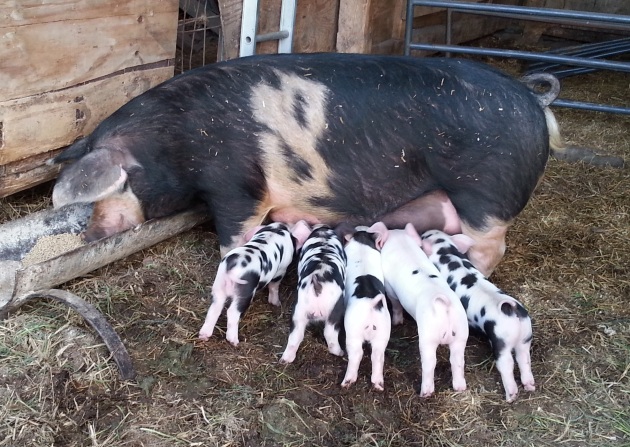
The number of cows, horses and pigs a farmer had could be limited by his ability to get them through the winter. Early on, not much hay was grown, and animals were expected to forage for themselves in the winter, with some hay and corn supplementing the browses. Hay that would not fit in the barn could be piled under a roof outdoors. Hay could be cut out with a special knife to be fed as needed to the animals.
With the establishment of a new U.S. government, and a new county, Rensselaer, as the 18th century drew to a close, farmers began to expand beyond bare subsistence farming. While they still grew much of what they fed their families, as the 1800’s advanced, farmers diversified, growing other grains: barley, oats, rye, and corn. They began to produce for local industry. In the first quarter of the 19th century, the local textile mills processed and spun linen and wool, so the farmers grew flax and sheep. Then the mill owners transitioned to cotton or imported flax from Europe, so farmers had to find other sources of income.
As one can see from inventories of estates in probate files, farmers grew a little of everything, being quite self-sufficient. They had a few cows for meat and dairy, a few pigs for meat and lard, a few chickens for eggs and meat, and a few geese for feathers, perhaps sheep for wool for home use and/or to sell. If there was surplus milk, it was made into cheese and butter, which could last better to sell. They grew feed for the animals- corn and hay-, grain to be ground locally for flour, and potatoes for domestic consumption and to sell. They had a couple of bee hives for honey. Of course they cut wood for fuel for stoves for heat and cooking. And they had an apple orchard to make cider and hard cider for home or perhaps for sale. There were a couple of cider mills on the local streams.
Let me give a couple of examples of the above from various inventories in probate files. More at the modest end, James Wool, who lived off Fogarty Road, died in 1805. He two cows, and six sheep, plus a spinning wheel and some wool cards, indicating that his wife probably used the wool the sheep produced. He also had some woodworking tools, perhaps pointing toward a specialization as a carpenter. Andrew Weatherwax, who also lived in the southern part of town, died in 1811. He had three cows, including a red one with the horns sawed off, three heifers, a yoke of steers, two horses, seven swine and a sow with pigs, 11 sheep, and 17 geese. He left a “mow of wheat in the sheaf” (meaning it was mown and bundled in the field,) and one of oats, plus seven tons of hay, 90 bushels of corn, and flax in bundles, along with 65 bushels of potatoes, 15 bushels of wool and 30 of flax. Andrew grew feed for his animals, but also flax and wool to be sold to the local mill. He also had two large and two small spinning wheels, along with yarn for 20 yards of cloth, woolen yarn for blankets, and linen yarn for 15 yards cloth. This indicates that someone in his household was spinning more than would have been used at home, spinning yarn to be sold to be woven into fabric. There is no loom on the inventory. Andrew also had one plow, one harrow, three hoes, two scythes, a grindstone, and a fanning mill. A fanning mill separated the wheat from the chaff mechanically, saving the toil of threshing and winnowing by hand.
Lewis Viele, who died in 1804, was a descendant of the earliest settlers in town. His inventory included basic tools, just one plough, one scythe, and some hand tools, plus nine cattle, nine swine, 16 sheep, five horses, some bushels of corn, rye, wheat, oats, and buckwheat, three pounds of wool and 60 of flax plus casks of meat, a cask of feathers, eleven geese, and six fowls. Lewis also had three slaves: a negro man who sold for $187.50, a boy 12, and a girl, 14, each worth $100. Different than other inventories at the same time, he had 21 pictures in his house, which I would love to have seen. Since this was well before the invention of photography, these could have been engravings, etchings, or oil paintings.
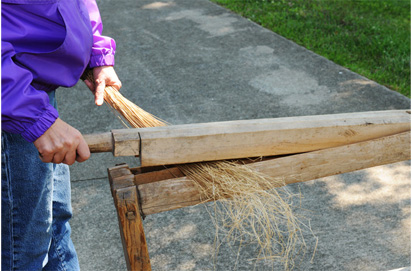
flax break
John Groesbeck died in 1812. His farm was in the Albany Corporation Lands at Schaghticoke and had been farmed by Groesbecks for a couple of generations. John’s probate inventory really shows a breadth of crops. He had seven horses of different kinds, sixteen cattle, seven “young hogges,” and 38 sheep, plus ten geese and 40 fowls and two bee hives. Besides growing the feed for all those animals, he had the tools to go along with them: the harnesses, collars and bridles, ploughs, an “iron bound wagon,” a lumber slay (sic), plus a sheep shear, an “iron bound” churn, plus the pitch forks, rakes, cradles, and scythes for the hay and wheat. John also grew flax, so had a flax brake and hetchel to use in processing it, plus a bigg (sic) and little spinning wheel, a loom, and a dye pott, indicating that the fibers were processed on the farm. He also had various iron tools- a shovel, chains, hand saw, planes, augurs, crow bars, and axes. There were storage vessels: corn baskets, cider barrels, meat tubs, small casks, stone pots. Mrs Groesbeck, Sylvah, was cooking with 18th century tools: brass and iron kettles, tin pans, a spider (frying pan with legs,) tin and wooden pails, fire tongs and andirons, earthenware crockery, baskets. She cooked over an open hearth. I must add that she had a “humberilla,” a looking glass and a set of 6 chocolate cups and saucers, so life was not totally plain.
Peter Yates, who had been the Colonel of the local regiment in the Revolution, died in 1807. He lived on River Road, just north of its junction with Pinewoods Road. He was a farmer, and had a huge estate, leaving hundreds of acres in a couple other locations to his children. He also left an island in the Hudson River just north of his land to one daughter, “to cut fencing stuff.” Fences were an important part of farms, and usually made of wood. Peter also left a bushel of salt, worth 87 cents, to each child. This was an important commodity for food preservation as well as seasoning.
Peter had farmed on a much larger scale than the men of the preceding paragraphs, partly because he owned seven slaves to work for him. He had seven milk cows, four oxen, two bulls, two heifers, two calves, and one three-year-old steer, plus seven horses, 14 swine, and 19 sheep. His inventory really reflects the self-sufficiency necessary in the 18th century, including a set of blacksmith tools and one of carpenter tools, plus a cider mill. He had a drag, harrow, two plows, pitch forks, and a lumber sleigh and tools, plus irons for a rope walk (where he could make his own rope), a dung fork, and an “old fanning mill.” Owning an island, he had a “ferry scow and tools” to get there. Crops included 56 bushels of wheat, 100 bushels of rye, 70 or oats and 35 of “old corn”, plus 105 bushels of swingled flax (that is processed), and 20 tons of hay. Each child got at least one calf skin, but I don’t know if the tanning was done on the property. Peter and his workers and children could have produced just about anything they needed on the farm- except for that salt.
William Myers, Sr. died in 1826. His farm was where Brock’s farm on Fisherman’s Lane is today. William had four horses, 18 cows, 34 sheep, and eight hogs. Farm tools included a plow, corn plow, cradle (grain cradle), several scythes, a fanning mill, hay forks, a drag, hay rigging, a scoop shovel, and a fanning mill. Harvested crops were: 120 bushels of oats, a mow each of rye, hay, corn stalks, and wheat, a bunch of flax, 13 bushels of barley, 5 tons of hay, 25 bushels of wheat, a lot of buckwheat, 120 bushels of oats, and a “lot” of beef and pork- probably in barrels. There were also hetchels (for processing flax), a “big wheel” (for spinning wool), and a loom, showing that at least some of the fibers were processed at home.
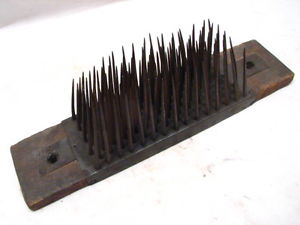
hetchel
Farmers have always been quick to adopt new tools and methods to save them work. The first U.S. patent was granted for a fanning mill- a machine to separate wheat from chaff- in 1806, with the second granted to Oliver Barrett, a local man, in 1808, though there were certainly fanning mills before then. Two inventories from that period include fanning mills, that of Andrew Weatherwax of the southern part of town, who died in 1811, and James Wool, who lived off Fogarty Road and died in 1805. In each case, the machine was worth $6, quite a large amount for the time. By 1826, the date of the inventory of William Myers, above, the fanning mill was valued at $15. Mr Myers had another advance in farm tools, a grain cradle, which, combined with a scythe, allowed grain to be laid down neatly in the row for later collection as it was cut. It was developed about the same time as the fanning mill. He also had a corn plow. Of course iron plows had been around for a long time, but this was designed specifically for planting and/or cultivating corn. Many inventories had a grindstone, important for sharpening tools.
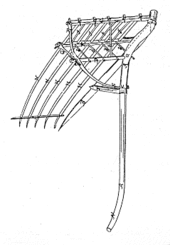
grain cradle
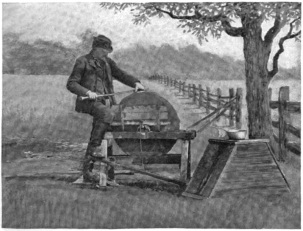
grindstone
A couple of the preceding inventories included oxen among the animals. One of the debates among farmers and the topic of articles in the agricultural journals of the 19th century was whether oxen or horses were better for working on farms. A writer in the “Genessee Farmer”, published in Rochester in 1849 stated that oxen are cheaper to keep as they don’t need grain, while one in “The Wool Grower and Stock Register”, another Rochester publication, stated in 1852 that horses work better in warm weather than oxen, while “The New England Farmer” of 1839 stated that oxen were good for breaking fallow fields, repairing fences, and carting manure, while horses were superior for plowing. I love the conclusion of the “Wool Grower and Stock Register”, good advice for anyone: “long intervals of repose for man or beast, interspersed with great and unusual efforts, are in the highest degree injurious. Leave nothing to be done in the spring which can be done in the winter and nothing for the summer than can be accomplished in the spring.”
Post-Revolution farmers began to organize to help each other. The earliest state-wide organization I have found was the Society for the Promotion of Agriculture, Arts, and Manufactures, which began in 1791. As of an 1801 publication of its proceedings, Josiah Masters of Schaghticoke was the representative for Rensselaer County. Josiah may be better known to us as one of the founders of the Schaghticoke Powder Mill, U.S. Congressman, and county judge, but he was also a farmer on Masters Street. The articles in the publication range from “observations on the drilling of wheat” to “preserving and propagating trees”, to “thoughts on lime and gypsum,” to “advantages of domesticating elk and moose.” The Hessian fly was another concern. The Hessian fly supposedly arrived with the hay for the horses of the Hessian mercenaries who fought with British troops in the Revolution, and was and is a pest of barley, wheat, and rye. This 1801 publication indicated it had originated on Long Island.
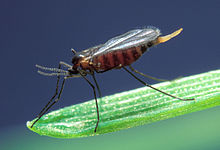
Hessian fly- pest of wheat
According to Anderson’s “Landmarks of Rensselaer County,” the Rensselaer County Agricultural Society began in 1819. George Tibbits, one of the largest landowners in the county, was the President, and Herman Knickerbocker of Schaghticoke was first vice-president. Herman was also a busy lawyer, politician, and judge, younger son of our famous Knickerbocker family. The Lansingburgh managers were Wooster Brookins and Smith Germond of Speigletown and Bethel Mather was the Schaghticoke manager. Wooster Brookins was the son of James, who owned the home just north of D.L.C. Electric on Route 40. Smith Germond owned the hotel at the junction of Route 40 and Fogarty Road. And Bethel Mather owned the farm where M and T Bank is today- that junction was known as “Colonel Mather’s Four Corners.” Schaghticoke committee members were William B. Slocum, Nicholas Masters, and John Groesbeck. William B. Slocum was a farmer and cattle dealer who lived in the Speigletown area of town. Nicholas Masters was the brother of Josiah from the preceding paragraph, both owners of the Schaghticoke Powder Mill. They lived on today’s Master Street. And Grosbeck was the most common surname in Schaghticoke in 1820…I’m not sure which John Groesbeck this was.
When George Tibbitts spoke at the first meeting of the society, he said that farming practices had not changed since the county was settled, with soils exhausted, and crops failing as a consequence. Besides improving agricultural practices, the society sought to encourage industry, as better farm and home tools could leave farmers more time to improve their farming. In 1820, Herman Knickerbocker gave the address at the society’s annual meeting. He spoke on manures, preparation of earth for receiving seeds, crop rotation, and different kinds of grain, fruit, and cattle for different soils, as well as hedges and fences.
One of the early members of the society was Edmund Genet, “Citizen Genet.” Genet (1763-1834) had come to the U.S. in 1793 as an ambassador from France, and stayed after the French revolution. He married a daughter of Governor George Clinton and lived as a gentleman farmer in East Greenbush. Members of the agricultural society did all sorts of surveys of soils and experiments in types of fertilizers, seeds, and cultivation. The results were disseminated in the local newspapers, in specialized agricultural newspapers, and in speeches. They put on fairs so that farmers could show off the results of their hard work and teach others. The first county fair was held on grounds “south of Hoosick Street” in fall 1819.
Anderson’s “Landmarks of Rensselaer County implies that the Rensselaer County Agricultural Society continued on until today, with changes in the location of the fairgrounds over the years. The Schaghticoke Fair implies the same thing. But I think the first try at the society failed, as there is a full report in the Troy newspapers on the founding of the organization again in 1834. This would suggest it had failed and was being restarted. The organizational meeting was held at the Mansion House in Troy on January 14, 1834. The Committee to draft a constitution included four men from Schaghticoke: Bethel Mather, Abraham Knickerbocker, Nicholas M. Masters, and John I. Viele. Smith Germond of Speigletown, was involved as well. Edmund Genet was the first President, but he died that year, and when the group met again that fall, Bethel Mather was elected President. I find it interesting first,that primarily the same Schaghticoke people stayed involved, and second, that one of their number became the President.
The group decided not to attempt a fair that year, but to concentrate at getting members. They also appointed representatives to attend the New York State Agricultural Society meeting. That organization had begun in 1832. It promoted agricultural innovation and improvement, and began publishing its “transactions” in 1841, giving farmers another way to access information on new farming techniques. Among the topics discussed by the society at the time were drilling (planting) wheat, preserving and propagating trees, thoughts on lime and gypsum ( used as fertilizer), and “on domesticating elk and moose,” plus manures, preparation of earth for receiving seeds, crop rotation, different kinds of grain, fruit and cattle for different soils, and hedges and fences.
The first fair of the re-established Rensselaer County Agricultural Society was finally held on October 4-5, 1842 in Batestown, which was a part of Lansingburgh. Besides premiums offered at the fair for best animals and crops of different sorts, the Society also awarded prizes to whole farms. In 1842, Abraham Knickerbacker of Schaghticoke offered his farm for inspection. The results were published in the “Transactions” of the agricultural society the following year. He had 330 acres, 100 of which was bottom land on the Hoosic River. He also cultivated 115 acres of upland and had 115 acres of wood. He reported a great crop of wheat planted where he had had clover hay the year before. It was unfortunately damaged by rust, a fungal disease which was just starting to really impact NYS wheat crops. The author of the article about the winning farms reported that he had a “well-systematized and praiseworthy rotation” of crops, with clover every fourth year. He top dressed his fields yearly with plaster (lime), 1 ½ bushels per acre. Every April, Abraham appraised his stock, farming utensils, and produce on hand. He kept good records of his debt and credit. Thus he could review and improve his operations. The full report of the Society appeared in the Troy “Daily Whig” that fall, which reported that the “outbuildings of the farm are numerous, large, and well-arranged.” Abraham’s name appeared as both organizer and winner in following fairs.
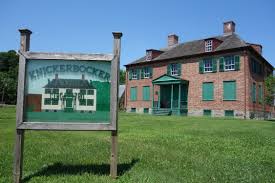
Knickerbocker Mansion, home farm of Abraham Knickerbocker
Of course Abraham was of the famous Knickerbocker family of Schaghticoke. He was the youngest of the four sons of Johannes Knickerbocker (1751-1827). His father left over 1000 acres at his death, in three farms. Abraham, born in 1796, inherited the home farm, and lived in the mansion house. He was a wealthy farmer, firmly settled in the economic elite of the county, though his place was not as firm as that of his father as new manufacturers made a lot of money and gained status. Abraham’s brother, Herman, entered politics and government and had a textile mill, though he ended up with no money.
The 1855 NYS Census recorded that Abraham had 259 improved and 130 unimproved acres. The farm was valued at about $20,000, the animals at $2000, and the tools at $840. The year before he had grown an acre of spring wheat, 30 acres of rye, 12 acres of buckwheat, 30 acres of corn, one acre of turnips, and three acres of potatoes. He had picked 200 bushels of apples, and made ten barrels of cider. He had killed one cow for beef the previous year, and milked nine cows which produced 1300 pounds of butter. He had 100 fowls, six horses, twelve pigs, and 110 sheep which produced 480 pounds of wool. This wool was certainly intended for the local woolen mill. He was now using gypsum guano as fertilizer.
As of 1855, Abraham was 59 years old, wife Mary was 49. They lived with their son Henry, 33, a 61-year-old lady named Miss Nasroe, two house servants, and two farm laborers. Those four servants were Irish immigrants. By 1865 Henry had moved on, but son Joseph, gentleman, was living at home. Miss Nasroe was listed as an aunt. Joseph stayed on at the mansion after the death of his father in 1869.
Another winning farm in 1842 was that of Daniel Fish in Pittstown. Though he was not in my town, I’m including him as I particularly liked the listing of the types of fence employed on his farm: picket; board, painted and common; stump; sod; stone wall; and rail, plus use of blind and open ditches. I think that a blind ditch is another term for a French drain. Fencing was more to keep other farmers’ animals out of gardens than to keep them in. Early town records include the poundmaster as one of the town officials. His job was to corral loose animals. In addition, Daniel had drained marshes, adding to his pasture land. Another award-winning farmer planted his corn on clover sod, which he turned in between May 10 and 20.
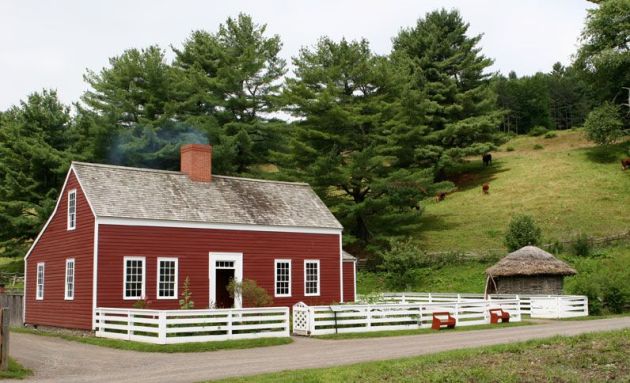
Farmers Museum, Cooperstown- note the fence to keep animals out of the kitchen garden
All farmers were encouraged to eliminate the very invasive Canada thistles, either by frequent plowing or cutting them before they went to seed. This was even mandated in town law in the 1840’s. The “Transactions” of the Agricultural Society also included a long article encouraging farm wives to go into the production of silk. This meant their husbands needed to plant mulberry, the food for silk worms, but they would harvest the cocoons and wind the silk. We know that this was an experiment that did not succeed! There are a couple of columns to report on silk grown in the 1855 New York State census, but in the Schaghticoke portion, at least, those headings are crossed out by hand and categories for poultry added instead.
In 1843, the Rensselaer County Agricultural Society offered three premiums (prizes) per town for the best three cultivated farms. Henry P. Strunk, whose farm was on the west side of Route 40, almost into Washington County, was the first place winner. He had 156 acres of sandy loam, 116 under cultivation. He had the whole farm divided into lots of 12-15 acres by post and board fences. He grew wheat, rye, oats, and corn, with 12 acres of meadow and 14 fallow acres, plus 28 acres of pasture in clover and timothy. Henry had two pairs of matched horses, a two-year-old colt, plus 12 milk cows, seven hogs and nine shoats (young pigs).
The 1850 census reports that Henry P. Strunk was born in 1800. As of that date, his farm was valued at $8,000. He and wife Elener, 48, had three children living with them that year: Mary J., 21, Julia, 18, and Martha, 14, plus a farm laborer, John A. Groesbeck, 24. Henry and Elener actually had six children: there were two other daughters, Maria and Harriet, plus a son, Philip. Philip had moved to Wisconsin by 1850. The 1855 census states that Henry had 126 improved and 20 unimproved acres, valued at $7800. The animals were worth $1000, and the tools $150. The previous year, he had grown ten acres of winter wheat, 33 of oats, 14 of rye and one of buckwheat, plus 14 of corn and ten of potatoes. He had 100 fowl, and milked ten cows, producing 1000 pounds of butter. He had three horses and 37 pigs. This range of crops is a fairly typical of medium-sized farm of the time from what I have read.
As you might imagine, when Henry died in 1858, the inventory of his estate revealed many farm implements: hoes, potato forks, corn cutters, spades, cultivators, three ploughs, grind stone, scythes, four grain cradles, a corn sheller, rakes, a fanning mill, plus two two-horse wagons, and two sleighs. He had 14 pigs, four cows, 20 fowls, and 16 turkeys. It seems to me that he must have disposed of at least his horses himself before his death, if not some other animals. In a list of items retained for the use of the widow, there was just one horse, one one-horse wagon, one one-horse sleigh, and a set of harness, plus one cow and two pigs. He also left a few acres of corn, potatoes, and rye.

girandole
From the inventory of the interior of the house, Henry and Elener lived well. The house was carpeted, including the stairs. They had a mahogany table, 12 parlor chairs, a mirror, 3 sets of window curtains and “fixings”, and 3 girandoles. A girandole is “a branched support for candles or other lights,” which either stands on a table or is attached to the wall. They also had three lamps. The only wall decorations mentioned were wall maps of Schaghticoke and Rensselaer County. The only book mentioned is a Bible. They had several stoves, presumably for heat in the rooms, and a Stewart cook stove in the kitchen. Elener had two sets of dishes, 12 silver tea spoons, and a pair of sugar tongs, among other dishes and glassware. She also had a spinning wheel and a loom, three churns, and a wash tub. It is interesting that she had both loom and spinning wheel, while the farm had no flax or sheep. Perhaps they were historical artifacts at this point, or she may have bought the fiber elsewhere.
Henry must have been either a generous man or a poor judge of character, as he didn’t owe any money when he died, but was owed a total of $2500 by a dozen people. The prospect of collecting all of these debts was listed as “doubtful.” But at least one of the debts was understandable, about $1500 to his son-in-law George Leslie. Daughter Maria Leslie received nothing from the estate as a result.
Elener continued to run the farm in the years after Henry’s death. She died in 1864, and left a spring calf, two 2-year old heifers, 1 yearling heifer, one cow, 45 Dunghill fowl (chickens), six shoats (young pigs) and two hogs, and 1 turkey with ten chicks., plus lots of unthrashed oats, hay, 12 acres of rye, 4 ½ acres of potatoes, 10 acres of corn not gathered, 13 acres of buckwheat and 20 acres of rye on the ground, all more than when Henry died.
Second place farm winner awarded by the Rensselaer County Agricultural Society in 1843 was Colonel Isaac Tallmadge, who had 255 acres around the junction of what are now Master Street and Bunker Hill Road, where the Stark farm is now. The farm was divided into lots of equal size, each of which opened onto a road with an English swing gate. His crops were the same as Strunk, above, with the addition of buckwheat, potatoes, and ten acres of flax. He had five horses, 16 cattle, 17 hogs and 29 shoats, plus 300 sheep. He used forty tons of plaster per year on his fields, plus all of the manure of his animals. Amazingly, he had two miles of stone wall on his farm, topped by 10,000 chestnut rails. Two of his three barns had basements for his sheep, and all the outbuildings were painted. His farm must have been gorgeous.
Isaac was born in Dutchess County in 1787. He moved to town with his parents and a couple of siblings before 1800. He married Lucinda Canfield in the Schaghticoke Dutch Reformed Church in 1808. At the time of the war of 1812, he was in the 45th Infantry Regiment, the local militia organization, as a lieutenant. He was gradually promoted over time, finally reaching the rank of Colonel some time after 1820. He and Lucinda had at least two sons, but son James, father of at least five children, died in 1853, leaving son William as his father’s heir when Isaac died in 1867.
As of the 1850 census, Isaac’s farm was valued at $16,000. He and wife Lucinda had a granddaughter, also Lucinda, born in 1836, living with them. I’m not sure who her parents were. In 1850 they had two servants: Abigail Sheldon, 45, and Michael Irish, 25, an Irish immigrant, in the household. Isaac must have hired farm labor as he needed it, or had hands who didn’t live in. In the 1855 census, Isaac reported 215 improved and 40 unimproved acres, worth $12,750. His animals were worth $1374 and tools $200. The previous year he had grown six acres of winter wheat, ten of oats, twenty of rye and corn, and five of potatoes. He had grown flax for another mill in town, producing 2 ½ tons of lint (fiber) on fifteen acres, plus 150 bushels of seed. The flax seed could be processed as well, producing oil and animal feed. Isaac had sixty fowl, milked four cows, and had five horses and 18 pigs. He also raised 140 sheep, producing 500 pounds of fleece for the local wool mill. More than many other farmers, Isaac was growing for the local market for both wool and flax.
Isaac was very involved in the Rensselaer County Agricultural Society until at least 1860. His name appears in the Troy papers as a member of the executive committee of the organization, which was formed in 1841, as a member of the committee on farms, and as a winner- having the 3rd place wheat in 1844, and having produced 11 bushels of flax seed and 258 pounds of dressed flax from one acre, having the best sheep at the fair in 1851, and having a “remarkably fine” three-year-old short horned Durham cow in 1858. During the time of his involvement, the Agricultural Society acquired fair grounds on the east side of Lansingburgh and erected a number of fair buildings.
The third place farm in 1843 was that of Lewis Buffett. It was 166 acres in between the village of Schaghticoke and the Hoosic River, which had several oxbows. Three of his thirteen lots were surrounded by the Hoosic River, meaning the land was rich, flooded yearly, and needed no manure. Lewis had the same crops as the others, with three acres of potatoes. He had just four horses, 16 cattle, and six hogs.
Lewis Buffett was an ancestor of the billionaire Warren Buffett. Lewis’ father, Jesse, came to Schaghticoke from Long Island after the Revolution, and was a prominent local innkeeper. Lewis was born in 1802. He did not marry. The 1850 census listed him with a farm worth $13,800. He had a housekeeper, Catherine Armstrong, 21, and an Irish farm laborer, William Case, 30 and his wife Hannah, 25, living with him. On the 1856 map of town, his name is on the map to the east of Pleasant Avenue, just south of where the Hoosic Valley Elementary School is now. I believe his farm was sold to John A. Baucus, whose name appears in that spot on the 1876 Beers map. By 1870, Lewis had retired from farming, and lived on the east side of Route 40 in the village of Schaghticoke just south of where Pleasant Avenue branches off, so not far from his farm. He died in 1872.
Lewis was very involved in Whig party politics from at least 1837-1860. I found him in the Troy papers as a chairman of the Schaghticoke Whigs and delegate to the County Whig Convention on a number of occasions. He appears in town records only as having been a school commissioner, so while he was very active in politics, he was not an office holder.
I will end my story of agriculture at this point, as I reach mid-century. I’d love to find out more about farms in general- it seems that men planted for their own use and for the local markets- for example, flax and sheep, but also dairy products, which could not have been transported far in the days before the railroad and refrigeration. In the mid-1800’s, some, at least, spent lots of time on buildings and fences. They must have hired local farm workers, but I don’t know how many and with what regularity. So this is not the end of my research.
I will note that the story of the Rensselaer County Agricultural Society is much more complicated than I thought. The Society had at least one re-start at the start of the 1800’s. To carry its history forward a bit, it worked hard to improve its grounds in Batestown, only to have the buildings burn in June 1852. The members bought new land, also in Lansingburgh, and rebuilt that same year. There was another fire in 1866, and the society went out of business and sold its grounds in 1874. After a re-organization in 1880, the fair started again in Rensselaer Park in 1882. By 1896 the fair was in Nassau, and by 1921 in Schaghticoke. I will go into much more detail on all of this in the future.
Bibliography:
Genessee Farmer edited by Daniel Lee and DDT Moore, 1849, Rochester NY p. 259
New England Farmer, Vol 18, 1839 p. 56
NYS Census 1855
Proceedings of the Rensselaer County Agricultural Society, First Annual Report, 1834, Troy, NY: in the NY Farmer and American Gardeners Magazine, 1835, New York
Transactions of the NYS Agricultural Society, Vol. II, 1842, Albany 1843
Transactions of the NYS Agricultural Society, Vo. III, 1843, Albany 1844
Transactions of the Society for the Promotion of Agricultural Arts and Manufactures, Vol 1, 1801, Albany NY
“Troy Daily Times” 1866, 1874, 1880, 1882, 1900, 1904, 1913- articles on the Rensselaer County Agricultural Society
“Troy Whig”, June 24, 1852, Sept 14, 1852
US Census 1810, 1820, 1830, 1840, 1850
The Wool and Stock Grower, vol IV, 1852-1853, Rochester NY p 176








